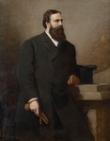This adaptation (and translation) of Jacques Offenbach's operetta Geneviève de Brabant was undertaken by Garnet Walch through a commission from W. S. Lyster for his Royal English and Opera Bouffe Company season at the Opera House, Melbourne. Based loosely on a legend dating back to the thirteenth century, Offenbach's story concerns the wife of the Duke of Brabant, who is accused of being unfaithful while her husband is absent (a further complication is that the duke and duchess are unable to have a child, because of a curse placed on them). The false accusation has been levelled by the Prime Minister, who wishes to take control of the country himself. His plan is defeated, however, by Genevieve and Drogan, a loyal pastry-cook. In Walch's adaptation, the storyline begins with Duke Cocorico being advised that political troubles are likely to arise in Brabant,on account of the disputed succession to the dcal throne. While discussing the problem, the duke is served a wonderful pie made by Drogan, which makes him ill. During his temporary illness, he is visited by Charles Martel, a paladin, who convinces him to go to Palestine on a crusade. They subsequently depart France via the Great Northern Railroad. With the duke now absent, Golo, Prime Minister of Brabant, plots to overthrow the duke by having his wife accused of adultery. He is aided in his scheme by the burgomaster, but they are frustrated by the genial and kindly influences of Drogan. When the duke eventually returns, the conspirators are unmasked (and pardoned) and the happiness of the entire population is expressed in an ecstatic fandango, as was customary in those days of Arcadian simplicity (details from Argus 13 September 1873, p.5).
The Age records that Walch's treatment varied in many respects from that adopted in England. 'By introducing a horde of small boys', writes the paper's theatre critic, he brings 'the play into rather too strong assimilation to the opening of a Christmas pantomime. The general character of the whole is of the broadest burlesque stamp' (12 September 1873, p.3). A similar view is again expressed in a review of the 1875 Opera House production: 'This opera is eminently a spectacular one and it is in this direction more especially that the deficiency is so marked' (Age 14 June 1875, p.3). The production also involved numerous topical and local hits at persons, issues, and events that were changed and/or updated for the revival seasons presented between 1874 and 1878. While noting that the local allusions added to 1874 revival were for the most part well accepted by the audience, the Age critic suggests that the libretto seemed to be antiquated, 'though only written some two years ago, so quickly do we travel in this age'. The critic's view was that it would require 'entire revision' to bring it up to-date (14 June 1875, p.3). In response to the 1878 revival, the Age notes that 'some effective hits' had once again been introduced. One particular reference (to the Chief Secretary) appears to have divided the audience drawing both applause and hisses following its delivery (23 April 1878, p.2). Walch also refashioned the lyrics of one song to take a good-humoured swipe at a well-known medical practitioner renowned for his love of diamonds.
The scenery and incidents advertised for the 1873 production are:
Act 1. Grand Palace in the City of Curacos (The Idyll of the Pie).
Act 2 Scene 1. Chamber in the Palace (The Nocturne Interrupted).
Act 2 Scene 2. Railway Station (Departure for Palestine and Grand March of the Duke's Army).
Act 3. The Hermit's Ravine (near Versailles), Working an Oracle, Inhuman Conduct of the Gendarmes, their Terrible Death and Resurrection.
Act 4. Versailles en fete, Grand Ballet, Denouement.

